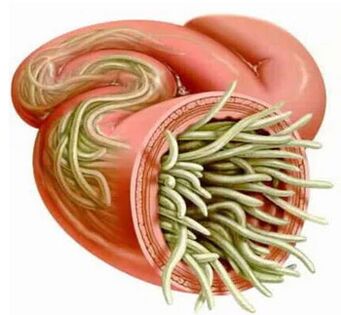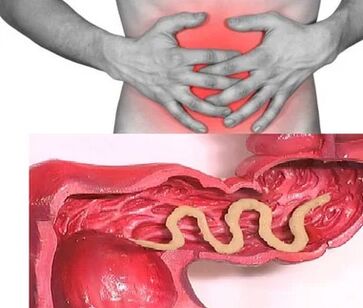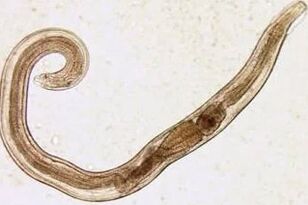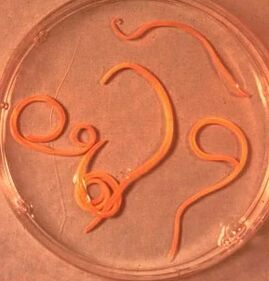So far, science is about 280 worms that can develop and live in the human body, parasitizing in various organs and tissues.The frequency of human infection depends on the climate and socio-economic status of a particular territory (in underdeveloped countries, especially in tropical and subtropical regions, the levels of parasite infection are much higher than those of economic development).
Methods of human infection:
- biogelmintosis (animal infection).
- contagioine helminthoses (from individual to individual).
- Geographically sensitive (a disease caused by parasites causes one of the important cycles on Earth).

Factors that affect worm performance
How parasites penetrate into the body:
- How well worms adapt to the human body;
- population density (number) of parasitic individuals;
- Worm habitat (tissue parasites live in the thickness of soft tissue, clearing them in the gaps of hollow organs).Some worms at various stages have educational and structural forms.Often, the larvae and developmental stages of the worms lead to more obvious pathological changes.
Without reinfection, the number of adult parasites in the human body will not increase.This feature can significantly differentiate worm invasion from diseases of bacteria, viruses, fungi and simple organisms.
Human worms: Symptoms
Worm disease is a disease characterized by two stages of the course (acute, two weeks to two months) and chronic (from several months to several years).
Symptoms of acute phase of helminthosis
The first sign of the disease can be at different times (after 2-3 weeks, acabani disease - often manifested after 2-3 days, and in oval, the incubation period can last 6-18 months).
In the acute phase of parasite invasion, the most characteristic symptom is an allergic reaction (antibody and antigen production of parasite migration larvae).Usually, itchy rashes, prone to disease course, recurring processes increase, regional lymph nodes appear on the skin, and extensive or local edema, muscle and joint pain may occur.Similarly, migrating larvae of parasites can cause chest pain, cough, suffocation, stool disease, nausea and vomiting.
At the same time, the acute stage of helminthiasis may be accompanied by more serious diseases (severe pneumonia, hepatitis, allergic myocarditis, liver cancer (increased in liver and spleen).
In the blood, the amount of eosinophils (eosinophils) increases, and the normal quantitative ratio between protein fractions (abnormal proteomics) is disturbed.

Signs of chronic worm disease
Symptoms of a chronic stage depend directly on which organ is "filled" by the parasite, and its size and number play an important role.
Therefore, when parasitized in the intestine of a single individual, the disease may appear asymptomatic (except for very large parasitic infection cases).The chronic stage of intestinal heart and encephalopathy is characterized by adverse diseases.The toxin and pain syndrome are more obvious in children.Using massive invasion of intraperitoneal, intestinal obstruction, mechanical jaundice and pancreatitis are possible.
By eating all the substances required for important activities in the host, worms can cause digestive disorders that violate the absorption of vitamins, minerals, carbohydrates, proteins and fats.At the same time, the product of worm lifespan inhibits the normal enteric bacteria and reduces the body's immunity.
In patients with helminths, the risk of malignant tumors is greatly increased due to the weakened immunity and the enhanced process of cell division (the consequence of the continuous recovery of tissue parasites).
Types of worms in the human body
The causes of human worm disease are 2 types of worms: round (nematode) and flat (ribbons and saucers).
Round worm
Pinworm
A thin cavity worm with small parasites (up to 10mm) caused by gastrointestinal diseases, with off-white color.The infection occurs in a digestive way (through the mouth).The reason is dirty hands.Parasite eggs can be on the ground, on the wool of infected animals, unwashed vegetables and fruits, etc.At the same time, self-expansion (especially in children) due to ophthalmocytics is not uncommon due to comb area and subsequent egg swallowing.Cutting larvae develops within two weeks in the digestive tract.Become an adult, worms parasitize in the small and upper lower part of the colon.

Ascarida
Askaride is a large parasite with a spindle-shaped form of red and yellow color, reaching an adult state of 40 cm (female) and 15-25 cm (male).If there are no suction cups or other fixing equipment, Ascaride can move independently towards the food community.The eggs sent by female parasites are distinguished by feces.
Academic infections can occur in the presence of soil particles or unwashed vegetables and fruits.After the egg penetrates the intestines, mature larvae emit from it.Then, on the intestinal wall, they reach the heart according to the blood flow, and then fall into the lungs from there.Through the pulmonary alveoli, the abdominal larvae through the respiratory tract penetrates into the oral cavity again.After repeated swallowing, the parasite reaches the small intestine, where it develops into an adult.The worm lived for 12 months, then died and stood out with feces.One or hundreds of people can live in the intestine of a master.
Frashv
Vlasov is a pathogenic drug for the hairy brain. It is a white worm that parasitizes in the initial part of the large intestine, reaching a size of 4-5 cm.The parasite is fed by blood and tissues of the rectal mucosa.
The sob eggs that the female put on the intestinal wall appear together with the feces.Their development occurs in the environment (optimal in the soil).The eggs of the parasite larvae penetrate into the body through dirty hands, water or unwashed vegetables and fruits.

Trichinella
The pathogenic drug of Trichinellosis is a small round rudder with a length of 2-5 mm.When using fried meat (pork, bear cubs, wild boars), infection occurs.Within 3-4 days, parasite larvae penetrate into the intestine, maturing the state of sexually mature individuals.The life expectancy of the worm is 40 days, after which the parasite dies.Drive the intestinal wall, the larvae penetrate the blood and carry it in all organs of the body, settle into the muscles.In this case, the bending of the respiratory and facial muscles, as well as the limbs, is usually affected.
In the first few days after the invasion, the patient complained about abdominal pain.Then, after about 2 weeks, the body temperature rose to 39-40 s, the rash appeared on the skin, muscle pain developed, and the face was swollen.During this period, in the case of large-scale infections, the risk of death is high.About a month later, recovery occurred.The parasite is encapsulated in a spiral form, after which it dies within two years.
Ankylostoma and non-core
These two parasites are similar through biological characteristics and the diseases they cause.Therefore, they are usually united by the general name (Ankylostoma).Worms reaching lengths of 10-15 mm are parasitic at 12-P.intestinal.It should be noted that this is one of the most common, but at the same time, parasites are rarely identified.When in contact with infected soil, the worm's worm penetrates the body through the skin.Furthermore, entering the blood, like the Akadridians, migrate to the lungs and then through the bronchials as well as phlegm-to the digestive tract.Anquilostoma is parasitic in the intestine and attaches to the intestinal wall.A parasite that is specially stinged with blood and can pierce the mucosa where it injects anti-swelling ingredients.During the day, adults can absorb an average of 0.05-0.35 ml of blood.Therefore, the most characteristic symptom of this worm disease is iron deficiency anemia and changes in the ratio of protein fraction (low proteinemia).
Flat worms
Wide tape
This is one of the largest worms, with a length of 10-20 meters.The disease caused by this parasite is called dicytosis.The worm development cycle begins with freshwater fish or crustaceans.The larvae enters the human body, which is the ultimate owner of a wide ribbon with caviar or infected fillets.Arriving at the small intestine, the parasite attaches to its walls and grows to a sexually mature individual on 20-25 days.
Liver bacon
The parasite that causes myxamosis is a flat worm with a length of 7-20 mm.It should be noted that more than 50% of liver disc infection cases (also known as cat biology) fall on Russian residents.After the egg falls into fresh water (swallowed from the snail), the parasite larvae begin to develop.Then they penetrate the fish's body (carp, Crook carp, whales, cockroaches).Human infection occurs when you eat infected fish that is not treated enough heat.The larvae of the liver bomb in the small intestine penetrated the bile duct and entered the gallbladder, and fixed there with two suction cups.
Bulls and pork
These parasites have almost the same structure as 5-6 meters.The infection of tusiarinhosis and tusiasis was caused by the use of cattle or pork.The visible Finns appear in the form of white bubbles, reaching a size of 0.5 cm, have been connected to a person's small intestine wall and become an adult within 3 months.Band-like parasites composed of more than 2,000 segments are growing.Meanwhile, the end portion containing the egg falls off, moves independently along the colon to the anal opening, then crawls out of the anus, or breaks away from the external environment with the feces.The most characteristic symptom of helminthosis is violation of the digestive tract.
echinococcus
For this parasite, one person is the middle host.Worms are parasitic in the human body in the form of Finns.The ultimate owner of echinococcus is a wolf, dog or cat.The infection is in contact with animals and environmental objects in a digestive manner and carries a handful of echinococcus eggs.After entering the intestine, tumor balls (six-leaf larvae) develop from it.From the intestine, they penetrate the blood and carry it throughout the body.
ALVEOKOKK
The parasite is considered to be a variety of echinococcals and is one of the most dangerous causes of helminthiasis (pneumococcal), similar to cirrhosis and liver cancer in severity.Infection occurs as intestinal bulbs (eggs with mature larvae) penetrate into the intestine.There, the embryo comes out of the egg and is introduced into the intestinal wall and penetrates into the blood.Furthermore, as the blood flows, the parasite spreads through all tissues and organs of the body (usually located in the liver).The main stage of development begins with larvae (multi-chamber bubbles, monsoon cysts)).Each chamber has an embryonic head of a parasite that continues to develop gradually.Toilets are very radical formations that grow constantly due to the increase of air bubbles and are able to sprout to the liver like cancer metastasis.
Diagnosis of worm disease
Diagnosis of worm invasion includes the following events:
- A thorough collection of anatomy helps identify possible causes of infection;
- The laboratory studies the content of feces, blood, 12p intestines, rectum and calcification mucus, muscle tissue, lung sputum, and bile.During the analysis, eggs, fragments or fragments of the parasite can be detected.At the same time, the increase in the content of eosinophils in the blood is also a signal of the existence of helminthiasis.
- Serological studies (ELISU, RSC, indirect agglutination, immunofluorescence analysis, etc.) were performed when diagnosing diseases caused by larval stages or tissue parasites.
- To identify worms that affect liver tissue, ultrasound, CT and endoscopic studies.
Human Worms: Treatment
In the acute phase of parasitic infection, patients are prescribed for detoxification and desensitization.In severe disease courses (hepatic irritation, trinucleosis), glucocorticoids are used according to medical indications.
As a drug for a specific therapy, special antiworming chemotherapeutic agents are prescribed considering the nature of the pathogen.
At the same time, patients are advised to take antihistamines and intestinal adsorbents.The final stage of treatment involves the use of probiotics that normalize the gut microbiota.
A special reserved diet is also specified (foods should be easy to digest and have almost no fat).
During deworming treatment, patients need to strictly adhere to personal hygiene (to avoid reinfection).Meanwhile, in many cases of worm disease, all family members and people who are subject to continuous contact should be treated.





















